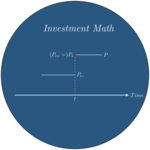Continuous Semimartingales
The previous posts introduced stochastic integration of an integrand \(H\) against an integrator \(M\) which was chosen to be a continuous martingale. Continuous semimartingales are now defined as continuous processes that can be decomposed into a continuous martingale and a continuous finite variation process. Because ‘standard’ integration theory allows to integrate against finite variation processes, one can easily extend stochastic integration from continuous martingale integrators to continuous semimartingale integrators.
